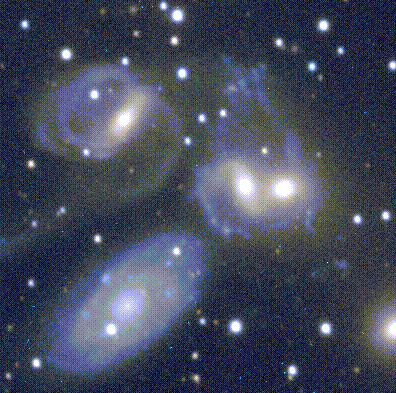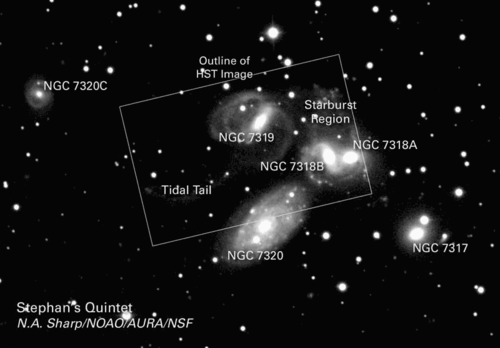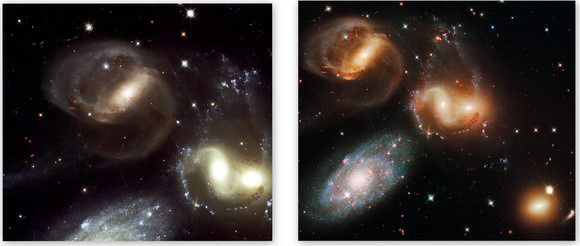Page 1 of 1
Stephan's Quintet (APOD 2009 September 11)
Posted: Fri Sep 11, 2009 4:17 am
by neufer
Re: Stephan's Quintet (APOD 2009 September 11)
Posted: Fri Sep 11, 2009 12:33 pm
by orin stepanek
Stephan's Quintet
Credit: NASA, ESA, and the Hubble SM4 ERO Team
Explanation: The first identified compact galaxy group, Stephan's Quintet is featured in this stunning image from the newly upgraded Hubble Space Telescope. About 300 million light-years away, only four galaxies of the group are actually locked in a cosmic dance of repeated close encounters. The odd man out is easy to spot, though. The four interacting galaxies (NGC 7319, 7318A, 7318B, and 7317) have an overall yellowish cast and tend to have distorted loops and tails, grown under the influence of disruptive gravitational tides. But the bluish galaxy at the upper left (NGC 7320) is much closer than the others. A mere 40 million light-years distant, it isn't part of the interacting group. In fact, individual stars in the foreground galaxy can be seen in the sharp Hubble image, hinting that it is much closer than the others. Stephan's Quintet lies within the boundaries of the high flying constellation Pegasus.
What can I say excepy Wow! Hubble rocks! 8)
Orin
Re: Stephan's Quintet (APOD 2009 September 11)
Posted: Fri Sep 11, 2009 1:21 pm
by bystander
Here is an earlier HST shot
APOD: 2000 Nov 13 - Disorder in Stephan's Quintet
What I find amazing is the number of background galaxies visible in today's apod.
Re: Stephan's Quintet (APOD 2009 September 11)
Posted: Fri Sep 11, 2009 1:22 pm
by geckzilla
Hubble was repaired just in time. Those astronauts have no idea what kind of disaster they averted here. Apod was reaching a critical shortage of astronomy pics!
The updgrade sure does pick up those little background galaxies a lot better. Or is it just refined technique?
Re: Stephan's Quintet (APOD 2009 September 11)
Posted: Fri Sep 11, 2009 1:55 pm
by bystander
geckzilla wrote:The updgrade sure does pick up those little background galaxies a lot better. Or is it just refined technique?
I think it's technology more than technique. Although both may have improved, WFC3 is obviously far superior to WFPC2. Amazing what a difference 10 years can make. Improvements in technique and software will make a greater impact on images from ACS, such as
NGC 6217 or
Omega Centauri.
Re: Stephan's Quintet (APOD 2009 September 11)
Posted: Fri Sep 11, 2009 4:32 pm
by billMe
It would be great to see what the sky look like living on a planet on the outer edge of one of these galaxies towards the center of the interaction.
Re: Stephan's Quintet (APOD 2009 September 11)
Posted: Fri Sep 11, 2009 6:02 pm
by Chris Peterson
billMe wrote:It would be great to see what the sky look like living on a planet on the outer edge of one of these galaxies towards the center of the interaction.
It would look similar to our own sky, but there would be a more complex Milky Way sort of pattern- for instance, while we see our galaxy as a faint band with some dust lane structure, if you were surrounded by interacting galaxies you'd see several bands at different angles across the sky. If you were actually centered in an area of interaction, you might see nothing but one big band- like the Milky Way covered the entire sky- a diffuse faint glow, probably with some darker dust structure in front.
One thing is for certain: it would look far less impressive from within than it does from here!
Re: Stephan's Quintet (APOD 2009 September 11)
Posted: Fri Sep 11, 2009 7:20 pm
by Sarba Guha
The "Blue Galaxy" is merely 40-million light years away while the others are 300-million light years away. The difference in distance is by a factor of 7.5 - right?
YET, the Blue Galaxy doesn't appear more than 2 to 3 times larger than any of the others.
Does that mean that those galaxies are twice, or even more than thrice as large, as the Blue Galaxy?
Can someone please comment on it?
Thanks.
Re: Stephan's Quintet (APOD 2009 September 11)
Posted: Fri Sep 11, 2009 7:35 pm
by Chris Peterson
Sarba Guha wrote:The "Blue Galaxy" is merely 40-million light years away while the others are 300-million light years away. The difference in distance is by a factor of 7.5 - right?
YET, the Blue Galaxy doesn't appear more than 2 to 3 times larger than any of the others.
Does that mean that those galaxies are twice, or even more than thrice as large, as the Blue Galaxy?
Nothing wrong with your logic. There is a very wide range of galaxy sizes, so there's nothing particularly odd about the foreground galaxy in this case happening to be smaller than the background galaxies.
Re: Stephan's Quintet (APOD 2009 September 11)
Posted: Fri Sep 11, 2009 8:01 pm
by bystander
Sarba Guha wrote:The "Blue Galaxy" is merely 40-million light years away while the others are 300-million light years away. The difference in distance is by a factor of 7.5 - right?
YET, the Blue Galaxy doesn't appear more than 2 to 3 times larger than any of the others.
Does that mean that those galaxies are twice, or even more than thrice as large, as the Blue Galaxy?
Chris Peterson wrote:Nothing wrong with your logic. There is a very wide range of galaxy sizes, so there's nothing particularly odd about the foreground galaxy in this case happening to be smaller than the background galaxies.
In the explanation to the image at Hubblesite.org, it calls NGC 7320 a dwarf galaxy, it's a lot smaller and a little closer than NGC 7331. Could NGC 7320 be a companion to NGC 7331?
http://internal.hubblesite.org/newscent ... 5/image/x/
http://apod.nasa.gov/apod/ap090806.html
Re: Stephan's Quintet (APOD 2009 September 11)
Posted: Fri Sep 11, 2009 8:18 pm
by neufer
Sarba Guha wrote:The "Blue Galaxy" is merely 40-million light years away while the others are 300-million light years away. The difference in distance is by a factor of 7.5 - right?
YET, the Blue Galaxy doesn't appear more than 2 to 3 times larger than any of the others.
Does that mean that those galaxies are twice, or even more than thrice as large, as the Blue Galaxy?
To be fair the Blue Galaxy (NGC 7320) is more like 4 times larger in apparent diameter
than any of the
undisturbed parts of the other Stephan's Quintet galaxies.
And the Blue Galaxy (NGC 7320) is more like 5 or 6 times larger in apparent diameter than the
undisturbed fifth member
of the
TRUE QUINTET (a.k.a., the Hickson Compact Group 92) as seen here in the far upper left:
If the Blue Galaxy (NGC 7320) is, indeed, 40-million light years away then, certainly, it is a somewhat small galaxy (~25-thousand light years in diameter or about half the size of
M33)...especially when one compares it to its
real nearby neighbor
NGC 7331 which is ~150-thousand light years in diameter.
Such large disparities in galactic size are seen in other
Hickson Compact Groups:
Re: Stephan's Quintet (APOD 2009 September 11)
Posted: Sat Sep 12, 2009 11:08 am
by DavidLeodis
Does the image show all five of the quintet.

If it does then is the small (relatively speaking) yellowish object to the bottom of the image one of the quintet or is the central object composed of two of the five as it seems to have two nucleii.

Re: Stephan's Quintet (APOD 2009 September 11)
Posted: Sat Sep 12, 2009 11:27 am
by DavidLeodis
Apologies if I seem to be a nuisance but I have another question. In the related Hubble news release it mentions that some of the image data was acquired by the UVIS on the WFC3 (Wide Field Camera 3). Just what does that UVIS stand for.

I know that Cassini has an Ultra Violet Imaging Spectrometer (UVIS) so I thought that might be what it stands for, but a search of the Hubble site brought up mentions of an "UV/visible (UVIS) channel" on the WFC3, so I'm now confused (as usual

).
Re: Stephan's Quintet (APOD 2009 September 11)
Posted: Sat Sep 12, 2009 1:04 pm
by Chris Peterson
DavidLeodis wrote:Apologies if I seem to be a nuisance but I have another question. In the related Hubble news release it mentions that some of the image data was acquired by the UVIS on the WFC3 (Wide Field Camera 3). Just what does that UVIS stand for. :?: I know that Cassini has an Ultra Violet Imaging Spectrometer (UVIS) so I thought that might be what it stands for, but a search of the Hubble site brought up mentions of an "UV/visible (UVIS) channel" on the WFC3, so I'm now confused (as usual :) ).
The new
WFC3 instrument has two channels; one covers near UV and visible (the UVIS channel) and one covers near IR (the IR channel). So on the HST, UVIS means something different than on Cassini.
Re: Stephan's Quintet (APOD 2009 September 11)
Posted: Sat Sep 12, 2009 1:38 pm
by DavidLeodis
Thanks Chris.
The use of the same acronym to mean different things can be confusing. I got confused when recent APODs relating to the Cassini Mission's Imaging Team started using ISS in the APOD credits, as it did not mean International Space Station but Imaging Science SubSystem/System.

Re: Stephan's Quintet (APOD 2009 September 11)
Posted: Sat Sep 12, 2009 2:55 pm
by bystander
DavidLeodis wrote:Does the image show all five of the quintet.

If it does then is the small (relatively speaking) yellowish object to the bottom of the image one of the quintet or is the central object composed of two of the five as it seems to have two nucleii.

Stephan's quintet really is a quintet. Although NGC 7320, the blue foreground spiral, is not a part of the same galaxy group, there is a another galaxy, NGC 7320c, off image to the upper right about the same visual distance from NGC 7319 (top right) as NGC 7317 (bottom left) that has the same approximate red shift as the other four galaxies making it a part of the group. It may be the
intruder that is causing the disruptions in NGC 7318a, 7318b and 7319. It has been said to be associated with the tidal tail seen at the top center of the APOD. The fifth galaxy can be seen in
APOD 2009 August 6 - Galaxies in Pegasus directly above this grouping at the bottom left.
http://chandra.harvard.edu/photo/2009/stephq/
http://chandra.harvard.edu/photo/2003/s ... index.html
http://apod.nasa.gov/apod/ap030812.html
Re: Stephan's Quintet (APOD 2009 September 11)
Posted: Sat Sep 12, 2009 4:08 pm
by DavidLeodis
Thanks bystander. Your stephq link brought up an image of Stephan's Quintet that had a labelled version when moving a cursor over. I saved a copy of that version but I do not seem to be able to paste it into this post. I assume the Img in the boxes is used to add an image to a post but I could still not get it to work.

and a bit

at my lack of know how.

Re: Stephan's Quintet (APOD 2009 September 11)
Posted: Sat Sep 12, 2009 10:28 pm
by bystander
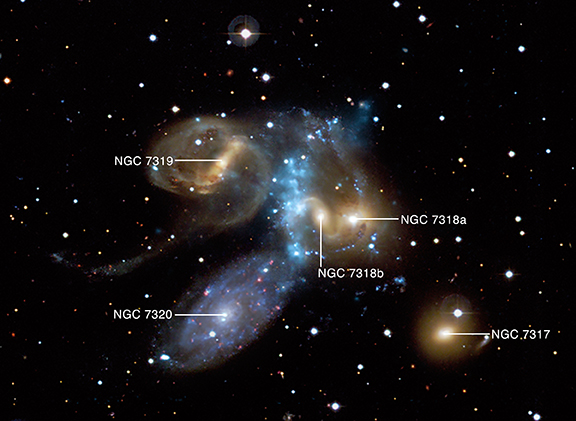
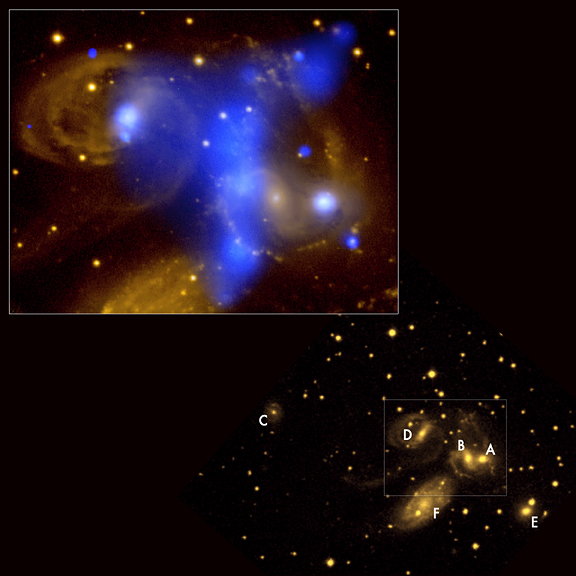
Stephan's Quintet: Intruder Galaxy Shocks Tightly-Knit Group wrote:The four galaxies A, B, D and E strung out diagonally across the wide field optical image are at a distance of about 280 million light years from Earth. The large-appearing galaxy F in the lower left of this image has now been identified as a foreground galaxy at a distance of about 35 million light years, leaving the group originally identified as Stephan's Quintet with only a quartet of galaxies. However, if we include galaxy C, which is at the same distance as the other four galaxies, it becomes a quintet again!
Re: Stephan's Quintet (APOD 2009 September 11)
Posted: Sun Sep 13, 2009 2:46 pm
by DavidLeodis
Thanks again bystander. You have been very heplful.
Re: Stephan's Quintet (APOD 2009 September 11)
Posted: Thu Sep 17, 2009 3:19 pm
by bystander
